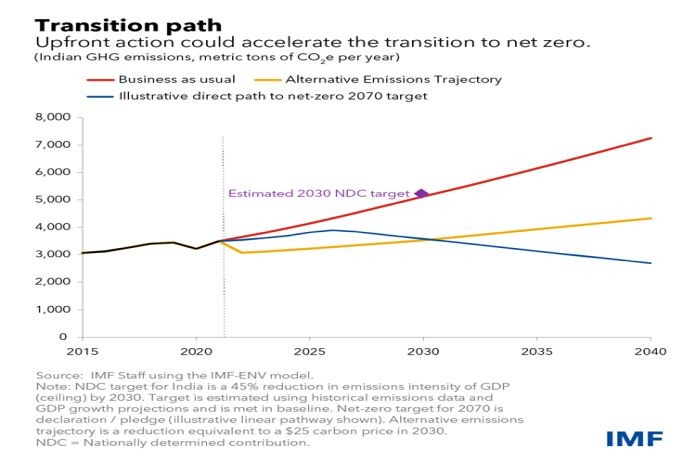– Further adoption of clean energy will accelerate the transition to net zero while saving lives, boosting fiscal revenues, and promoting energy security.
By Margaux MacDonald and John Spray
India is shifting toward greater renewable energy generation while striving to improve energy access, affordability, and security. It’s also poised to be one of the fastest growing economies in coming years, which will in turn sharply boost energy demand. Whether it meets those needs with fossil fuels or green alternatives has the potential to shift the trajectory of its greenhouse gas emissions for many more years to come.
India has made significant progress towards meeting its emissions reductions targets under the Paris Agreement, but with current policies total GHG emissions would nonetheless increase by more than 40 percent by 2030. While a modest increase in short-term emissions may be necessary to meet poverty reduction and energy security goals, a more rapid scaling up of current policies could help lower emissions considerably over the medium-term and bring India closer to a path to net zero by 2070.
As in most countries, achieving net zero will require adjustments to how people live, work, and get around – and some of these changes will be costly. But upfront action could lower the cost. First, India is expected to increase investments in coal-fired power plants, but by limiting these investments, substantial irreversible fixed costs could be saved. Second, early scaling up of renewable energy allows for a more gradual policy adjustment, which may be less politically costly, and for a more continual adoption of new technologies. Costs can also be amortized over longer periods.
Our research shows an alternative emissions trajectory could be achieved by scaling up current policies. One of our proposals includes a gradual increase in subsidies on the use of renewable energy coupled with higher taxes on emissions, in addition to the many targeted policies that India has focused on. This would have the added benefit of early reduction in the reliance on imported fuels, helping to ensure universal access to energy, and of lessening the negative health effects from pollution. External climate financing and technology transfer would help mitigate costs and ensure sustainability.
In our model, combining renewable subsidies and higher tariffs on coal (roughly equivalent to ramping up India’s existing excise duty on coal) would result in nearly one third lower emissions by 2030 compared to current policies. In this scenario, growing energy demand is met through a gradual increase of renewable energy and by allowing coal power to taper off, thus exceeding the goal of 50 percent non-fossil fuel electricity capacity. Under such a policy, not only would the share of renewables rise significantly but overall electricity supply would increase.
While this policy has clear environmental benefits, we estimate that the policy will result in a modest reduction in the level of real gross domestic product (relative to projections based on current policies) as firms and consumers pay higher taxes. However, enough fiscal revenues would be raised to compensate the poorest citizen to such an extent that the policy would be progressive overall. Additionally, the small cost of this policy is less distortionary than other options.
Lower emissions would have significant benefits. Increasing renewable energy usage and allowing coal to taper-off in this policy scenario would lead to a 2.5 percent reduction in pollution, saving lives and leading to fewer missed school and workdays. It would also decrease coal imports by 14 percent by 2030, thus increasing resilience to global changes in energy prices and improving energy security.
Margaux MacDonald and John Spray are economists in the IMF’s Asia and Pacific Department. This article reflects research contributions from Geetika Dang and Sneha Thube.





